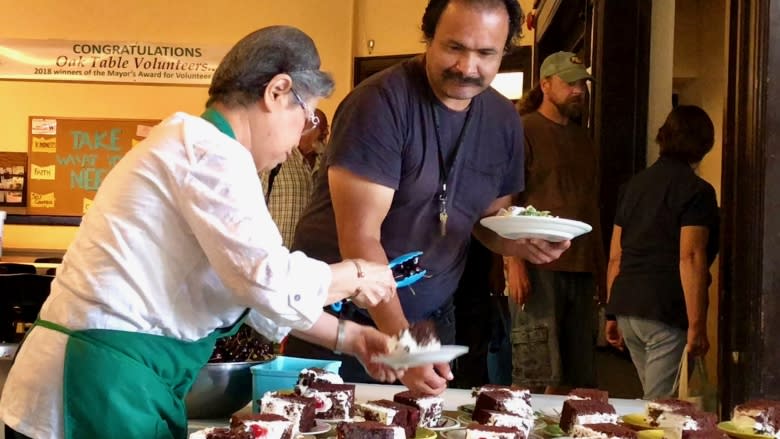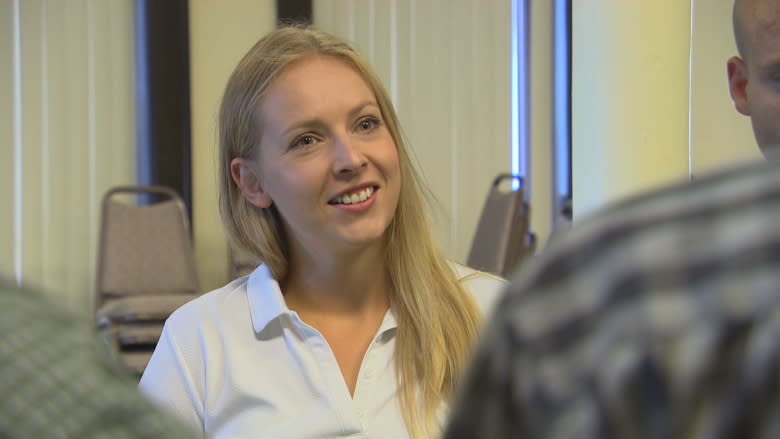'These folks can't wait until 2030': Federal anti-poverty strategy needs more concrete plans, says advocate
Some people in Winnipeg living on a low income — and those working to help them — say they're a little skeptical about a new federal government commitment to reduce poverty.
The Liberal government's anti-poverty plan, called "Opportunity for All — Canada's First Poverty Reduction Strategy," was unveiled Tuesday in Vancouver. It calls for a 20 per cent reduction in the rate of poverty from 2015 levels in the next two years, and a 50 per cent reduction by 2030.
"These folks can't wait until 2030," said Tessa Whitecloud. She speaks for a group called 1JustCity, a Winnipeg non-profit organization that feeds about 400 people a day.
"There needs to be a clearer path where we can say, 'OK, these are the steps they're going to take until they're housed, till they're healthy, till they have enough to eat.' And that's not in this announcement," she said at a lunch program in Augustine United Church Tuesday.
"We are setting official targets for reducing poverty," Social Development Minister Jean-Yves Duclos said in Vancouver Tuesday.
"Canada has to be a world leader in showing the rest of the planet that we can be better at helping everyone achieve their full potential and that's why these targets are perfectly realistic and perfectly aligned with our international obligations."
But there's no new money to do any of that.
Ottawa will use about $22 billion in previously announced spending for the strategy, including the child benefit, workers benefit and the Guaranteed Income Supplement.
Although she'd like to see more concrete plans, Whitecloud said she's happy to see the federal government making poverty reduction a priority.
"I'm looking forward to the ways that we can work with this strategy and hopefully be a part of some of those consultations to make sure that the folks that we love, and are taking care of at our doors, have what they need."
She's not counting on the federal government alone, though.
"We're going to be continuing to call on our donors to make that a reality."
'We dig in the garbage cans'
Tuesday's announcement doesn't mean much to those living in a tent city off Main Street, either.
Al Urrutia, a flood evacuee from Pinaymootang First Nation, where residents were forced to leave their homes in 2011, is one of a couple dozen people who live there.
Asked what they need, Urrutia answered, "Housing. Proper housing."
"It's a first priority for our people," added another woman at the tent city.
Then there's the question of food.
"Oh my gosh. Do we ever eat? Nothing. We dig in the garbage cans," Urrutia said.
The federal government says it is consulting with Indigenous groups and communities, and Employment and Social Development is working to fill some of the data gaps on First Nations, aiming to include specific indicators that will help them track progress on-reserve.
Urrutia and his friends say the federal government has to do more to respect their treaty rights and share resources so Indigenous people can be more self-sustaining.
They also say local chiefs and councils need to be more fair in the way they provide houses and jobs.
For them, even 2020 is a long way away, and they don't have a lot of hope their situation will change between now and then.
"Poverty is a sad thing. It's a sad story. We have to do this every day," Urrutia said.
Just over two million Canadians will need to be lifted out of poverty if Canada is to reach its target of a 50 per cent reduction in the poverty rate by 2030.
Governments have made commitments like this before, including one by Parliament to eradicate child poverty by the year 2000.
The latest figures show there were 4.8 million Canadians lived in low-income households in 2015.
Nearly one in four were children.




